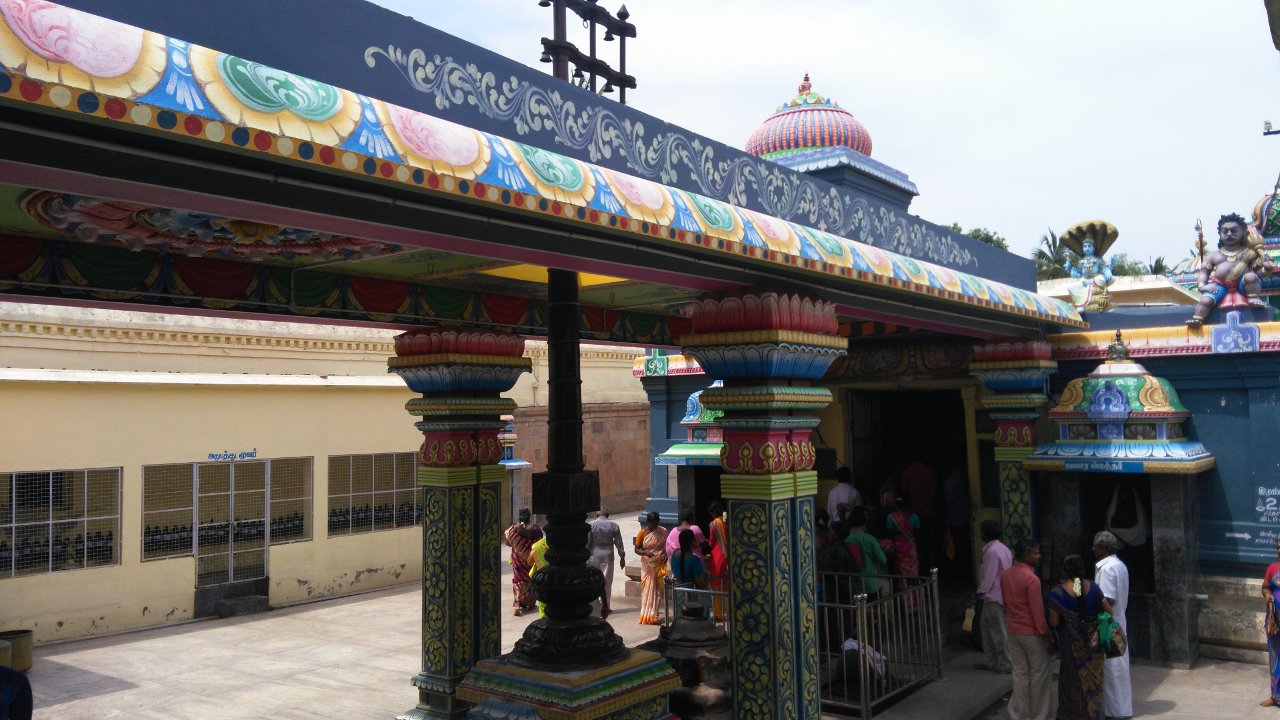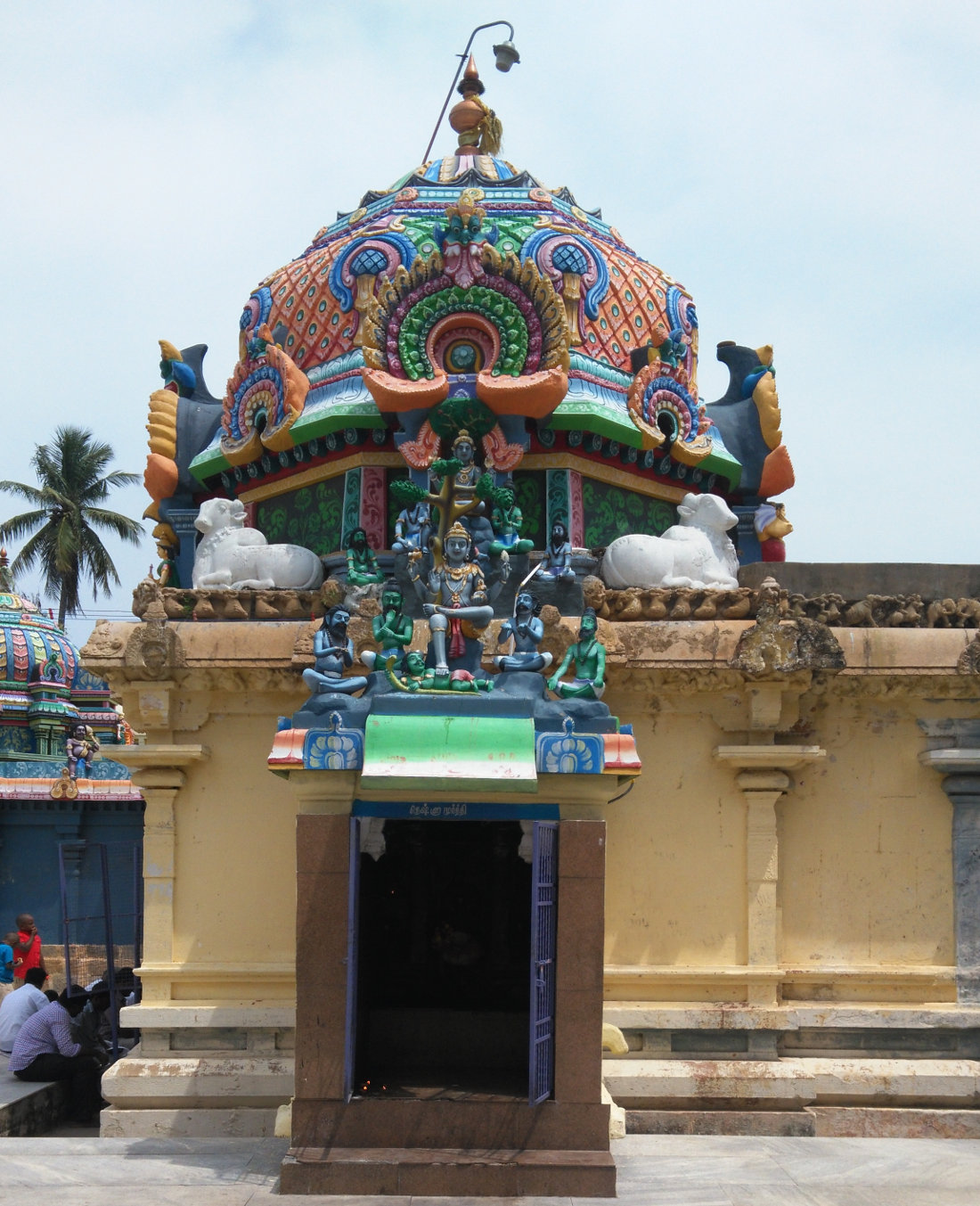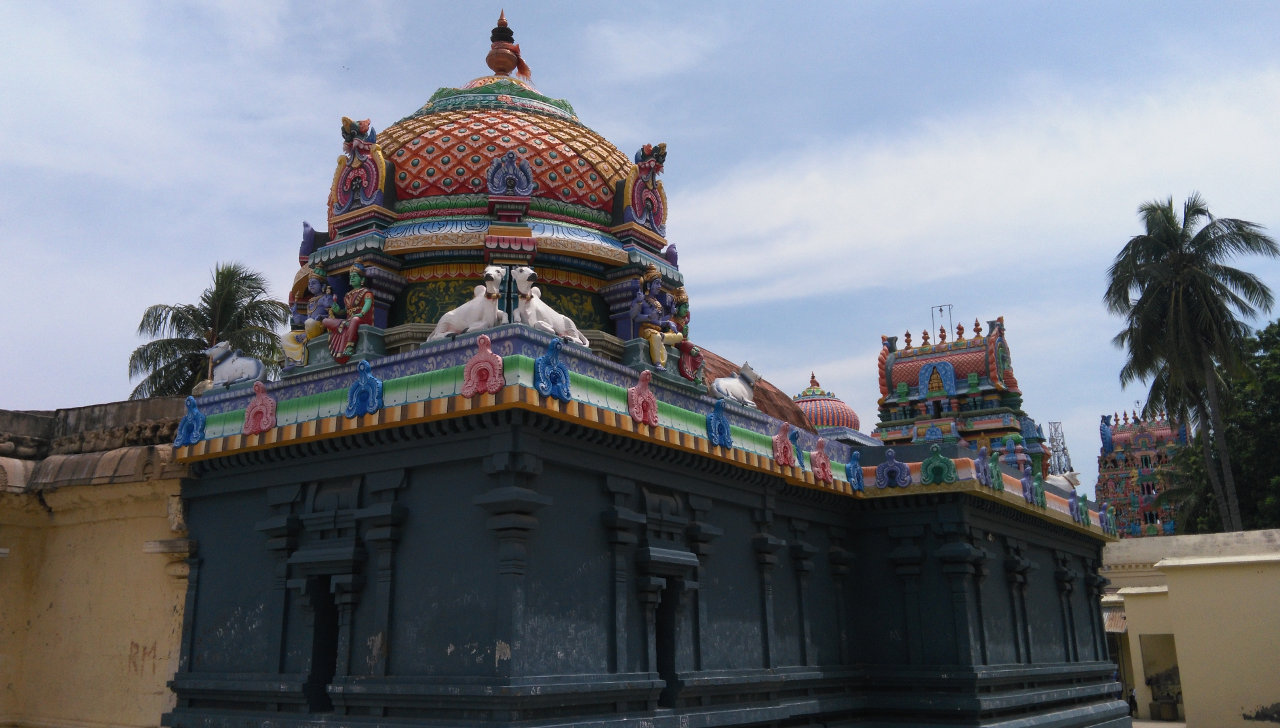Visited on: 1st October, 2017.
Location
Thirukkarukavur is situated at a distance of about 20 kms from Tanjure on the Tanjure to Kumbakonam (Via Thittai-Melattur-Papanasam) route. It is about 20 kms from Kumbakonam. Nearest railway station is Papanasam on the Mayiladuthurai to Tanjure line, which is about 5 kms away from this place.
Other Devara Paadal Petra Shiva Sthalams near this place are – Thengudi Thittai, Thiruppulla Mangai (Pasupathi Koil), Sakkarappalli (Iyampettai), Thiru Nallur, Aavoor, Pazhayarai Vada Thali, Thiru Sakthi Mutram, Patteeswaram and Thiru Paalaithurai.
General Information
| Moolavar | Sri Mullaivananathar, Sri Garbha Pureeswarar, Sri Madhavi Vaneswarar |
| Ambal | Sri Garbarakshambigai, Sri Karumpanaiyalammai, Sri Karukatha Nayaki |
| Theertham (Holy water) | Brahma Theertham, Ksheera kundam, Sathya Koopam, Vrudha Cauvery. |
| Sthala Vriksham (Sacred Tree) | Jasmine Plant (Mullai) |
| Pathigam (Hymn) rendered by | Saint Thirugnanasambanthar-1 and Saint Thirunavukarasar (Appar)-1 |
- This is one of the 276 Devara Paadal Petra Shiva Sthalams and 18th Shiva Sthalam on the Southern bank of the river Cauveri in Chozha Nadu (Thenkarai).
- Lord Shiva in this temple is a Swayambumurthi (self-manifested).
- This temple is very famous and devotees throng this temple in large numbers praying for child boon and safe delivery.
- This east facing temple has two corridors and its main tower (Rajagopuram) has 5-tiers.
- There are two Nandhis here along with the flag post and Balipeet.
- The last consecration ceremony (Kumbabishekam) took place on 29.01.2016 and prior to that on 08.03.1993 and 27.10.1985.
History of the Temple
This ancient temple is believed to be over 2,000 years old and is situated on the banks of the river Vettaru. This temple is spread over 3 acres of land.
There are stone inscriptions in this temple which date back to the periods of Chola kings Koppara Kesari Varman and Raja Rajan-I.
The historical names of this place are Mullaivanam, Garbapuri and Madhavivanam (Madhavi means “Mullai” plant, a variety of jasmine).


There are five Devara Paadal Petra Shiva Sthalams at different places in the Thanjavur, Kumbakonam and Thiruvarur regions which are revered as “Pancha Aranya Sthalams”. Thirukkarukavur is one among them. “Pancha” means five and “Aranyam / Vanam” means forest in Tamil. In ancient times, these regions were densely forested. These five temples are –
1. Sri Mullaivananathar Temple at Thirukkarukavur with “Mullai” forest (vanam);
2. Sri Satchi Nathar Temple at Avalivanallur with “Paadhiri” forest (vanam);
3. Sri Paathaaleswarar Temple at Thiru Aradaipperumpazhi (Haridwara Mangalam) with “Vanni” forest (vanam);
4. Sri Aapathsahayeswarar Temple at Thiru Irumpoolai (Alangudi) with “Poolai” forest (vanam); and
5. Sri Vilvavaneswarar Temple at Thirukkollampudur with “Vilva” forest (vanam).
Worshiping the lord at these five temples in a single day is considered to be auspicious. These temples should be visited in the order given above at the following times - early morning, morning, noon, evening and night respectively. It is also believed that Saint Thiru Gnanasambanthar worshiped Lord Shiva at these temples in this order. It is believed that by worshiping the lord in these 5 temples in this prescribed order, devotees will be absolved of the sins of their previous birth. It is also believed that such worship would help devotees break away from the repetitive cycle of birth and re-birth.
This temple is under the administrative control of the Hindu Religious and Charitable Endowments Department of Government of Tamil Nadu (HR&CE).
Legend
According to legend, the lingam was found in the midst of jasmine plants here. Hence the lord is praised as “Sri Mullai Vana Nathar”. The mark of the creepers around the lingam can be seen. This lingam is big in size and is a self-manifested lingam that formed from the mud of an ant-hill. It is always covered with a metal bowl (“Kuvalai” in Tamil). Hence, no “abhishekam” is performed to the lingam directly and only “Punuhu” (civet) is applied. Devotees who are afflicted with incurable diseases come to this temple during Pradosham days of the full moon fortnight, offer "Punuhu Chattam" to Lord Shiva to seek relief for their afflictions. The lord is also praised as “Sri Bhavaroga Nivaaranan” as he is believed to be the lord who relieves devotees from their sins.
Legend of Sri Garbarakshambigai
Another legend associated with this temple is that of Vedhikai, wife of Sage Nithruvan. It is believed that both lived in this place and worshiped Sri Mullaivana Nathar and Goddess Parvathi in order to be blessed with a child. Once, when Vedhikai was in an advanced stage of pregnancy, she became very tired and was taking rest in her house. Her husband was not home at that time. Incidentally, another sage by the name of Urthuvapadar, who was passing by her house, was thirsty and tried to call someone from the house. In spite of his repeated calls, no one came out. When the sage looked inside the house, he saw Vedhikai asleep. Not realising that she was pregnant, he cursed her and went away. Due to this curse, her foetus got disintegrated.
When Vedhikai woke up and realised that someone had visited her house, she came out and saw the Sage Urthuvapadar leaving. She then noticed that something was wrong with her body as she felt uneasy. Afraid that the sage might have cursed her, she prayed to Goddess Parvathi for help. The Goddess appeared before her, protected the foetus by preserving it in a “Kalas” (sacred pot) until it developed to a fully grown male child. The parents named their child as “Naidhuruvan”.
Vedhikai again approached the goddess for help as she had no milk to feed her child. The goddess directed Kamadhenu, the divine cow, to this place to feed the child. It is believed that Kamadhenu created a “Milk tank” (“Ksheera kundam”) by scratching the earth in front of the temple with her hoof. This tank can still be seen today.




It is believed that when Sage Nithruvan came to know from his wife what had happened, he prayed to the goddess that she protect all the pregnant women who visits this place to worship her. Goddess Parvathi agreed to his request and is believed to be blessing the devotees since then. Hence, the goddess is praised as “Sri Garbarakshambigai”. “Garbham” means pregnancy, “Raksha” means “to protect” and “Ambikai” means goddess in Sanskrit. Similarly, the Tamil name “Sri Karu Katha Nayaki” is derived from “Karu” meaning foetus, “katha” meaning protector and “nayaki” meaning goddess. It is because of this incident that this place gets the name “Thiru Karu Katha Oor”. It has now been changed to Thiru karu kavoor.
It is believed that Lord Brahma, Chandran and Kamadenu have worshiped the lord here. Kings Kujaththuvasan, Sangukarnan and Punniyathuvasan and Sages Nithruvan, Gowthama and Kaarkkiyar have also worshiped the lord here.
Deities in the temple
Other than the shrines of Lord Shiva and Goddess Parvathy (Garbarakshambigai), shrines and idols of Niruthi Vinayakar, Venkatajala Vinayakar, Arumugar with his consorts, Gajalakshmi, Nalvar, 63 Nayanmars, Santhanachariyars, Bairavar and Suryan can be seen in the corridors.
Natarajar with Sivakami and Navagraham are placed in the main hall (Maha Mandapam). In the Navagraham, all the other idols are facing Suryan.
In the “koshtam” (place surrounding the sanctum sanctorum), idols of Vinayakar, Dakshinamurthy, Mahavishnu, Brahma, Durgai and Chandikeswarar can be seen.
There are separate shrines for the Shivalingams worshiped by sages Nithruvar, Karkkiyar and Gowthamar. Also, there is a Shivalingam in the corridor that is believed to have been worshiped by king Sangukarnan.






Salient Features
The procedure to worship goddess Parvathi here is –
For removal of obstacles from marriage proposals:
Devotees are advised to clean the sanctum’s steps with ghee, draw Rangoli and then perform the pooja.
For “Santhana Prapthi” (child boon):
Devotees are advised to clean the sanctum’s steps with ghee, draw Rangoli and then perform the pooja;
A portion of the ghee that is offered to the goddess is given back to the devotees. They have to consume it for 48 consecutive nights.
For safe delivery during pregnancy:
This temple offers castor oil after performing puja using it. Pregnant women are advised to apply it on the stomach during the time of labour pain.
On realisation of their wishes, devotees offer “Thulabaram” (any goods equal to one’s own weight) to the goddess here.
In this temple, Lord Murugan’s shrine is in between those of Lord Shiva and Goddess Parvathi. This type of structure is called as “Somaskanda” form. It is believed that circumambulating these three shrines together three times will yield a lot of benefit.
There is a hall in the shape of a chariot which houses the Shivalingam that is believed to have been worshiped by Sage Nithruvar.
It is believed that in this temple the Nandhi and Karpaga Vinayakar are Swayambu (self manifested).
In this temple’s Navagraham, all the planets are facing Suryan.
The special feature of this temple is that the moon's rays fall on Lord Shiva on the full moon day in the Tamil month of Panguni (March-April) every year.
This temple is considered to be significant for its three important attributes – Moorthy, Sthalam and Theertham - glory of Lord, sacredness of the land and the auspicious temple tank.
It is pertinent to note that many gynaecologists visit this temple and worship the goddess for their patients’ safety and successful delivery. Some doctors have contributed heavily to the renovation and reconstruction of this temple.
It is believed that in this village no women has ever died during pregnancy.
Greatness of this temple
Devotees throng this temple in large number to worship the lord and goddess to seek “Santhana Prapthi” (child boon), for removal of obstacles from their marriage proposals, and for safe delivery during pregnancy.
Important Festivals
Punugu Chattam is offered to Lord Shiva on all Pradosham days of the full moon fortnight.
1008 conches abhishekam is performed to Lord Shiva on all Sundays in the Tamil month of Karthikai (Nov-Dec).
Other important festivals celebrated in the temple are –
Aani Thirumanjanam in the Tamil month of Aani (June-July),
Vinayakar Chaturthi in the Tamil month of Aavani (Aug-Sept),
Navarathri in the Tamil month of Purattasi (Sept-Oct),
Annabishekam in the Tamil month of Aippasi (Oct–Nov),
Thiru Karthikai in the Tamil month of Karthikai (Nov-Dec) and
Thiruvadhirai in the Tamil month of Markazhi (Dec-Jan).
Pradosham is also observed regularly.
Temple Timings
From 06.00 AM to 12.30 PM and from 04.00 PM to 08.00 PM.
Temple Address
Sri Mullaivananathar Temple,
Thirukkarukavur,
Papanasam Taluk,
Tanjure District,
Tamil Nadu – 614 302.
Tele: +91 4374 273 423, 273 502, 88700 58269, 97891 60819.






Pathigam (Hymn) with English transliteration
Saint Thirugnanasambanthar visited this temple and sang this Pathigam.
Devotees visiting this temple should make it a practice to recite this Pathigam.
முத்தி லங்குமுறு வல்லுமை யஞ்சவே
மத்த யானைமறு கவ்வுரி வாங்கியக்
கத்தை போர்த்தகட வுள்கரு காவூரெம்
அத்தர் வண்ணம்மழ லும்மழல் வண்ணமே.
“Muththi laṅkumuṟu vallumai yañchavē
maththa yāṉaimaṟu kavvuri vāṅkiyak
kaththai pōrththakaṭa vuḷkaru kāvūrem
aththar vaṇṇam'mazha lum'mazhal vaṇṇamē”.
விமுத வல்லசடை யான்வினை யுள்குவார்க்
கமுத நீழலக லாததோர் செல்வமாங்
கமுத முல்லை கமழ்கின்ற கருகாவூர்
அமுதர் வண்ணம்மழ லும்மழல் வண்ணமே.
“Vimutha vallasaṭai yāṉviṉai yuḷkuvārk
kamutha nīzhalaka lāthathōr selvamāṅ
kamutha mullai kamazhkiṉtṟa karukāvūr
amuthar vaṇṇam'mazha lum'mazhal vaṇṇamē”.
பழக வல்லசிறுத் தொண்டர்பா வின்னிசைக்
குழக ரென்றுகுழை யாவழை யாவருங்
கழல்கொள் பாடலுடை யார்கரு காவூரெம்
அழகர் வண்ணம்மழ லும்மழல் வண்ணமே.
“Pazhaka vallasiṟuth thoṇṭarpā viṉṉisaik
kuzhaka reṉtṟukuzhai yāvazhai yāvaruṅ
kazhalkoḷ pāṭaluṭai yārkaru kāvūrem
azhakar vaṇṇam'mazha lum'mazhal vaṇṇamē”.
பொடிமெய் பூசிமலர் கொய்துபு ணர்ந்துடன்
செடிய ரல்லாவுள்ளம் நல்கிய செல்வத்தர்
கடிகொள் முல்லைகம ழுங்கரு காவூரெம்
அடிகள் வண்ணம்மழ லும்மழல் வண்ணமே.
“Poṭimey pūsimalar koythupu ṇarnthuṭaṉ
seṭiya rallāvuḷḷam nalkiya selvaththar
kaṭikoḷ mullaikama zhuṅkaru kāvūrem
aṭikaḷ vaṇṇam'mazha lum'mazhal vaṇṇamē”.
மைய லின்றிமலர் கொய்து வணங்கிடச்
செய்ய வுள்ளம்மிக நல்கிய செல்வத்தர்
கைதன் முல்லைகம ழுங்கரு காவூரெம்
ஐயர் வண்ணம்மழ லும்மழல் வண்ணமே.
“Maiya liṉtṟimalar koythu vaṇaṅkiṭach
cheyya vuḷḷam'mika nalkiya selvaththar
kaithaṉ mullaikama zhuṅkaru kāvūrem
aiyar vaṇṇam'mazha lum'mazhal vaṇṇamē”.
மாசில் தொண்டர்மலர் கொண்டு வணங்கிட
ஆசை யாரஅருள் நல்கிய செல்வத்தர்
காய்சி னத்தவிடை யார்கரு காவூரெம்
ஈசர் வண்ணம்மெரி யும்மெரி வண்ணமே.
“Māsil thoṇṭarmalar koṇṭu vaṇaṅkiṭa
āsai yāra'aruḷ nalkiya selvaththar
kāychi ṉaththaviṭai yārkaru kāvūrem
īsar vaṇṇam'meri yum'meri vaṇṇamē”.
வெந்த நீறுமெய் பூசிய வேதியன்
சிந்தை நின்றருள் நல்கிய செல்வத்தன்
கந்த மௌவல்கம ழுங்கரு காவூரெம்
எந்தை வண்ணம்மெரி யும்மெரி வண்ணமே.
“Ventha nīṟumey pūsiya vēthiyaṉ
sinthai niṉtṟaruḷ nalkiya selvaththaṉ
kantha mauvalkama zhuṅkaru kāvūrem
enthai vaṇṇam'meri yum'meri vaṇṇamē”.
(இப்பதிகத்தில் 8-ம் செய்யுள் சிதைந்து போயிற்று.
Ippathikaththil 8-m seyyuḷ sithainthu pōyitṟu).
பண்ணின் நேர்மொழி யாளையோர் பாகனார்
மண்ணு கோலம்முடை யம்மல ரானொடுங்
கண்ணன் நேடஅரி யார்கரு காவூரெம்
அண்ணல் வண்ணம்மழ லும்மழல் வண்ணமே.
“Paṇṇiṉ nērmozhi yāḷaiyōr pākaṉār
maṇṇu kōlam'muṭai yam'mala rāṉoṭuṅ
kaṇṇaṉ nēṭa'ari yārkaru kāvūrem
aṇṇal vaṇṇam'mazha lum'mazhal vaṇṇamē”.
போர்த்த மெய்யினர் போதுழல் வார்கள்சொல்
தீர்த்த மென்றுதெளி வீர்தெளி யேன்மின்
கார்த்தண் முல்லைகம ழுங்கரு காவூரெம்
ஆத்தர் வண்ணம்மழ லும்மழல் வண்ணமே.
“Pōrththa meyyiṉar pōthuzhal vārkaḷsol
thīrththa meṉtṟutheḷi vīrtheḷi yēṉmiṉ
kārththaṇ mullaikama zhuṅkaru kāvūrem
āththar vaṇṇam'mazha lum'mazhal vaṇṇamē”.
கலவ மஞ்ஞை யுலவுங் கருகாவூர்
நிலவு பாடலுடை யான்றன நீள்கழல்
குலவு ஞானசம் பந்தன செந்தமிழ்
சொலவ லாரவர் தொல்வினை தீருமே.
“Kalava maññai yulavuṅ karukāvūr
nilavu pāṭaluṭai yāṉtṟaṉa nīḷkazhal
kulavu gñāṉasam banthaṉa senthamizh
solava lāravar tholviṉai thīrumē”.







